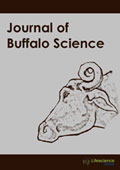jbs
Abstract : Scanning and Transmission Electron-Microscopic Studies on the Lingual Tonsil of the Buffalo (Bubalus bubalis)
|
|
Abstract: The present study examined lingual tonsil of six buffaloes of the local mixed breed by scanning and transmission electron-microscopy to elucidate their ultrastructural features. The lingual tonsil presented folded mucosa having longitudinally oriented folds which were separated by grooves. The surface mucosa showed a squamous arrangement of cells which delineated from the adjacent cells. The surface of these cells at a higher magnification presented the microplicae of different arrangements which were mainly of closed pattern type and resembled fingerprints of humans. The luminal openings of glandular ducts on the free surface presented varying shapes. The transmission electron-microscopy described ultrastructural details of the different strata of the stratified squamous keratinised, non-keratinised and reticular epithelia. The propria-submucosa contain reticular cells, fibroblast, lymphoid cells, plasma cells, granulocytes and interdigitating cells. Few high endothelial venules observed and the cytoplasmic process of these endothelial cells contained small vacuoles equivalent to vesiculo-vacuolar organelles, membrane-bound bodies and vacuolated structures. Keywords: Lingual tonsil, Microplicae, Vesiculo-vacuolar organelles, Buffalo. |
Abstract : Monoclonal Antibodies Specific to Water Buffalo (Bubalus bubalis) Myxovirus Resistance Protein_1
|
|
Abstract: Recombinant bubaline (Bubalus bubalis) myxovirus resistance protein 1 (bbMx1) was successfully expressed by an Escherichia coli expression system. After immunization and cell fusion, a set of ten mouse hybridomas producing mAbs to bbMx1 was established. The ten corresponding mAbs were further characterized using indirect ELISA, western blot analysis and immunocytofluorescent staining. Eight mAbs, designated 11C7, RD5, NF3, 9D1, FD4, PE6, 11A7 and 10F5, displayed binding abilities and specificity in the three formats. Moreover, combining NF3 (for capture) with RD5 (for detection), 9D1 with RD5, FD4 with 11C7 or PE6 with 11C7 generated a strong signal in a prototype sandwich-ELISA. The results suggest that the mAbs developed and characterized here provide an excellent starting point for developing diagnostic tools aimed at detecting viral infections in the water buffalo, whatever using immunoblotting, immunocytostaining or sandwich-ELISA. Keywords: Water buffalo, MX, antibody, biomarker, viral infection. |
Abstract : Short Communication: Heritability Estimation of Birth Weight of Swamp Buffalo in Sabah, Malaysia
|
|
Abstract: Data on birth weight of Swamp buffalo calves that were born between 2015 and 2017 were collected and analyzed for this study. The objective was to estimate the effect of heritability and to evaluate the influence of environmental factors on the birth weight of swamp buffalo calves. The heritability was estimated using parent-offspring regression method while the environmental factors were measured using linear regression analysis. The average birth weight for swamp buffalo calves was 31.5 ± 5.33kg. It was significantly (p<0.05) affected by the age of dam and the year of birth but the body weight of the dam and the sex of calves did not significantly (p>0.05) influence the birth weight. The heritability of birth weight was estimated to be 0.29, which is low. Therefore, environmental and herd management factors seem to play a larger role in birth weight than genetics. The low estimated heritability obtained from this work indicates that improvement through selection may not be feasible. Keywords: Heritability estimation, birth weight, swamp buffalo calves, environmental factors. |
Abstract : Phenotypic Characteristics of Shahi Strain of Nagpuri Buffaloes in Chandrapur District of Maharashtra, India
|
|
Abstract: Phenotypic Characterization of Shahi Strain of Nagpuri Buffaloes was done in the Chandrapur District of Maharashtra, India. Two hundred and forty Shahi strain of Nagpuri female buffaloes of various age groups were observed in their home tract (n farms=24). It was found that black coat colour, black coloured muzzle, white patches on the legs, whitish eyes, white coloured tail switch, horizontal ear orientation, sword-shaped horns with pointed tip first turning backwards and then upwards, bowl-shaped udder are typical characteristics of this breed. The average live body weight, body length, chest girth, height at withers, head length, breadth of head of these buffaloes is (means ± standard deviation) 433 ± 8.4 kg, 137.08 ± 2.78 cm 180.81 ± 3.84 cm, 129.43 ± 2.26 cm, 54.18 ± 1.10 cm, 28.18 ± 0.34 cm in 3 years and above age group, respectively. The average daily milk yield and milk yield per lactation of Shahi strain of Nagpuri buffaloes were observed to be 4.06 ± 0.08 kg and 1,220.84 ± 41.57 kg, respectively. Keywords: Nagpuri Buffaloes, Shahi strain, Phenotypic, Production, Breed Characterization. |






















